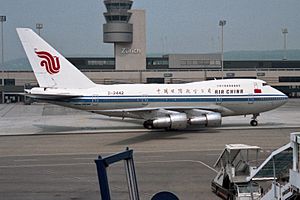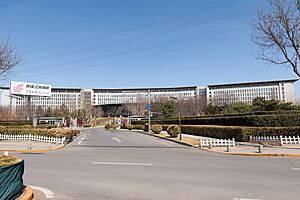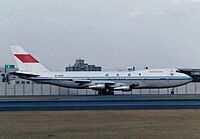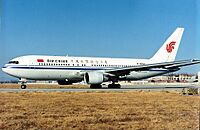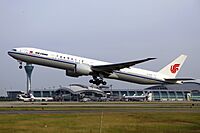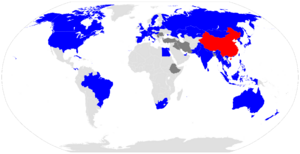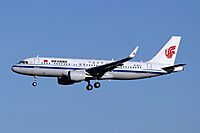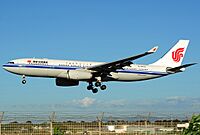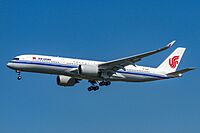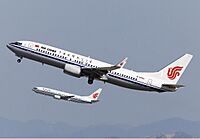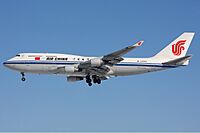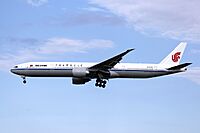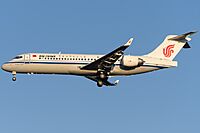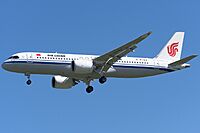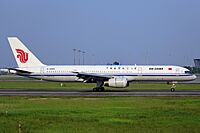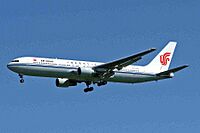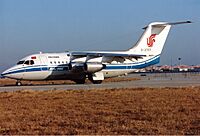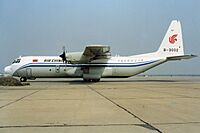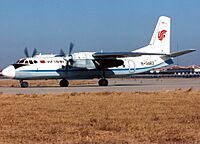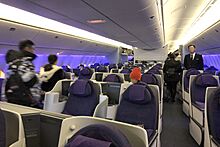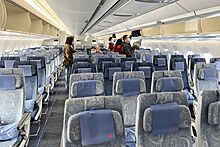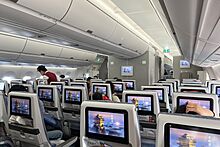Air China facts for kids

An Air China Boeing 747-8
|
|
| Founded | 1 July 1988 |
|---|---|
| Hubs |
|
| Secondary hubs |
|
| Focus cities | |
| Frequent-flyer program | PhoenixMiles |
| Alliance | Star Alliance |
| Subsidiaries |
|
| Fleet size | 505 |
| Destinations | 210 |
| Parent company |
|
| Headquarters | Beijing Tianzhu Airport Industrial Zone, Shunyi District, Beijing, China |
| Key people | |
| Revenue | |
| Operating income | |
| Net income | |
| Total assets | |
| Total equity | |
| Employees | 65,000 (2023) |
| Air China Limited | |||||||
|---|---|---|---|---|---|---|---|
| Simplified Chinese | 中国国际航空股份公司 | ||||||
| Traditional Chinese | 中國國際航空股份公司 | ||||||
| Literal meaning | China International Airlines, Company Limited by Shares | ||||||
|
|||||||
| Alternative Chinese name | |||||||
| Simplified Chinese | 中国国际航空公司 | ||||||
| Traditional Chinese | 中國國際航空公司 | ||||||
| Literal meaning | China International Airlines Company | ||||||
|
|||||||
| Air China | |||||||
| Simplified Chinese | 国航 | ||||||
| Traditional Chinese | 國航 | ||||||
| Literal meaning | National Airline | ||||||
|
|||||||
Air China, officially known as Air China Limited, is a major airline in China. It is the main airline for the People's Republic of China. Its main office is in Shunyi, Beijing. Air China flies to many places both inside China and around the world.
The airline started in 1988. This happened when the old Chinese airline, CAAC, was divided into six smaller airlines. Air China was one of them. Over time, it joined with some of these other airlines. Today, Air China is one of the biggest airlines in China. The Chinese government owns more than half of it through China National Aviation Holding.
Air China's main airports are in Beijing and Chengdu. In 2017, the airline flew 102 million passengers. About 81% of their seats were filled on average. Air China joined the Star Alliance group of airlines in 2007.
Contents
History of Air China
How Air China Started
Air China began flying on July 1, 1988. This was after the Chinese government decided to split the Civil Aviation Administration of China (CAAC) into six separate airlines. These airlines included Air China, China Eastern, and China Southern. Air China was given the important job of flying to other continents. It took over CAAC's large planes like Boeing 707s, 747s, and 767s.
In 2001, the six airlines that came from CAAC decided to merge. Air China took over China Southwest Airlines. Before this, Air China was the fourth largest airline in China for domestic flights. This merger made Air China much bigger. In October 2002, Air China officially joined with China National Aviation Holding and China Southwest Airlines.
On December 15, 2004, Air China's shares were listed on the Hong Kong and London Stock Exchanges. In 2006, Air China agreed to join the Star Alliance. It became a full member of this alliance on December 12, 2007.
In July 2009, Air China bought more shares in its airline partner, Air Macau. This increased its ownership from 51% to 81%. A month later, Air China also increased its ownership in Cathay Pacific from 17.5% to 30%. This helped Air China grow its business in Hong Kong.
Recent Developments
In April 2010, Air China took control of Shenzhen Airlines. This helped Air China become stronger in Beijing, Chengdu, and Shanghai. It also made its flight network across China more balanced.
On December 2, 2010, Air China received Spain's top tourism award. It was called the "Plaque for Tourist Merit." Air China was the first foreign airline to get this award. It is given to groups that help Spain's tourism industry.
Air China was the first Chinese airline to offer tickets that combine flights and shuttle bus services. This started on December 23, 2010. For example, you could fly to Beijing and then take a shuttle bus to Tianjin.
On November 15, 2011, Air China became the first Chinese airline to offer free Wi-Fi on its planes. However, passengers could only use it on tablets and laptops, not on smartphones.
In 2012, after talking with PETA, Air China announced it would no longer transport monkeys to laboratories. PETA was happy with this decision.
On July 3, 2013, Air China successfully tested Wireless LAN on a flight. This was a special event for the company's 25th anniversary. It was the first global satellite internet flight in Mainland China.
In early 2015, Air China chose Boeing 737 Next Generation and 737 MAX planes. These 60 new aircraft were part of its plan to update its fleet.
About Air China's Business
Air China Limited was officially registered in 2003. Its shares began trading in Hong Kong and London in December 2004. The company's main office is in the Tianzhu Airport Industrial Zone in Shunyi District, Beijing.
Air China's main base is at Beijing Capital International Airport. From there, it flies many long-distance routes to North America, Europe, South America, Africa, and Australia. Its fleet includes planes from Boeing and Airbus. These are planes like Boeing 737s, 747s, 777s, 787s, and Airbus A319s, A320s, A321s, A330s, and A350s. Air China also has hubs at Chengdu Shuangliu International Airport and Shanghai Pudong International Airport.
Air China's Brand and Look
The Air China logo shows an artistic Fenghuang (a mythical bird like a phoenix). This phoenix design also looks like the letters "VIP". The Chinese name of the airline is written in special handwriting by former leader Deng Xiaoping. The English name "AIR CHINA" is also on the planes. Air China is part of the Star Alliance group.
Where Air China Flies
Air China flies all over Asia, to the Middle East, Western Europe, and North America. Its main hubs are at Beijing Capital International Airport and Chengdu Tianfu International Airport. It also flies to many places in Asia, Australia, and Europe from Shanghai. Some international flights also leave from Chengdu, Chongqing, and other cities. Air China is one of the few airlines that flies to all six continents where people live.
On December 10, 2006, Air China started flying to its first South American city, São Paulo-Guarulhos in Brazil. This was the airline's longest direct flight.
Regular flights between mainland China and Taiwan began in July 2009. Because of the political status of Taiwan, Air China planes flying to Taiwan must cover the flag of the People's Republic of China on their side.
Air China added new Airbus A330-300 planes for long flights in summer 2011. These planes started flying to Düsseldorf, Germany. Düsseldorf became the third German city Air China served. The airline also started a new flight from Beijing to Milan-Malpensa in Italy on June 15, 2011.
The airline started getting 19 new Boeing 777-300ER planes in mid-2011. These planes became very important for its future long-distance flights. The new Boeing 777-300ERs replaced the older Boeing 747-400s on flights to U.S. cities like Los Angeles and New York. Air China also increased flights to New York. On January 21, 2014, the airline started direct flights from Beijing to Honolulu, Hawaii. This was the first nonstop flight between these two cities.
Air China also has agreements with many other airlines. These are called codeshare agreements. This means you can book a flight with Air China, but part of your journey might be on another airline. This helps passengers travel to more places easily.
Airlines Air China Works With
Air China shares flights with these airlines:
- Air Canada
- Air Dolomiti
- Air India
- Air Macau
- Air New Zealand
- Air Serbia
- All Nippon Airways
- Asiana Airlines
- Austrian Airlines
- Avianca
- Cathay Pacific
- China Express Airlines
- Egyptair
- El Al
- Ethiopian Airlines
- EVA Air
- Finnair
- Hawaiian Airlines
- Juneyao Air
- Kunming Airlines
- LATAM Brasil
- LATAM Chile
- LOT Polish Airlines
- Lufthansa
- MIAT Mongolian Airlines
- Scandinavian Airlines
- Shandong Airlines
- Shenzhen Airlines
- Singapore Airlines
- South African Airways
- Swiss International Air Lines
- TAP Air Portugal
- Tibet Airlines
- Turkish Airlines
- Uni Air
- United Airlines
- Virgin Atlantic
- WestJet
Air China also has interline agreements with Pakistan International Airlines.
Air China's Fleet (Planes)
Current Planes
As of June 2025, Air China uses these types of aircraft:
| Aircraft | In service | Orders | Passengers | Notes | ||||
|---|---|---|---|---|---|---|---|---|
| F | J | Y+ | Y | Total | ||||
| Airbus A319-100 | 23 | — | — | 8 | — | 120 | 128 | |
| Airbus A319neo | 1 | 9 | — | 8 | — | 120 | 128 | |
| Airbus A320-200 | 38 | — | — | 8 | — | 150 | 158 | |
| Airbus A320neo | 53 | — | — | 8 | — | 150 | 158 | |
| Airbus A321-200 | 61 | — | — | 16 | — | 161 | 177 | |
| 12 | 173 | 185 | ||||||
| Airbus A321neo | 30 | 50 | — | 12 | — | 182 | 194 | |
| 186 | 198 | |||||||
| Airbus A330-200 | 15 | — | — | 30 | — | 207 | 237 | |
| 18 | 247 | 265 | ||||||
| 12 | 271 | 283 | ||||||
| Airbus A330-300 | 28 | — | — | 30 | 16 | 255 | 301 | |
| 36 | 20 | 311 | ||||||
| Airbus A350-900 | 30 | — | — | 32 | 24 | 256 | 312 | Has two different Business Class seats. |
| Boeing 737-700 | 17 | — | — | 8 | — | 120 | 128 | |
| Boeing 737-800 | 87 | — | — | 8 | — | 159 | 167 | |
| 168 | 176 | |||||||
| 12 | 147 | 159 | ||||||
| Boeing 737 MAX 8 | 27 | 4 | — | 8 | — | 168 | 176 | |
| Boeing 747-400 | 2 | — | 10 | 42 | — | 292 | 344 | To be retired. |
| Boeing 747-8I | 7 | — | 12 | 54 | 66 | 233 | 365 | B-2479 and B-2481 used for VIP transport. |
| Boeing 777-300ER | 28 | — | 8 | 42 | — | 261 | 311 | |
| — | 36 | 356 | 392 | |||||
| Boeing 787-9 | 14 | — | — | 30 | 34 | 229 | 293 | |
| Comac C909 | 35 | — | — | — | — | 90 | 90 | |
| Comac C919-100ER | 4 | 101 | — | 8 | — | 150 | 158 | Deliveries from August 2024 until 2031. |
| Air China Business Jets fleet | ||||||||
| Boeing BBJ1 | 1 | — | VIP | Operated by Beijing Airlines. | ||||
| Boeing BBJ2 | 3 | — | VIP | |||||
| Dassault Falcon 7X | 1 | — | VIP | |||||
| Total | 505 | 164 | ||||||
Past Planes Air China Used
Air China has used these aircraft types in the past:
| Aircraft | Total | Introduced | Retired | Notes |
|---|---|---|---|---|
| Airbus A340-300 | 6 | 1997 | 2014 | |
| BAe 146-100 | 4 | 1988 | 2008 | |
| Boeing 707-320 | 6 | 1988 | 1993 | |
| Boeing 737-200 | 4 | 1988 | 1995 | Disposed to Air Great Wall. |
| Boeing 737-300 | 44 | 1988 | 2014 | |
| Boeing 737-600 | 6 | 2003 | 2009 | |
| Boeing 747-200M | 3 | 1988 | 2000 | Converted into freighters and transferred to Air China Cargo. |
| Boeing 747-400M | 4 | 1989 | 2013 | |
| 3 | Converted into freighters and transferred to Air China Cargo. | |||
| Boeing 747SP | 4 | 1988 | 2000 | |
| Boeing 757-200 | 9 | 2003 | 2013 | Converted into freighters and disposed to SF Airlines. |
| 4 | Converted into freighters and transferred to Air China Cargo. | |||
| Boeing 767-200ER | 5 | 1988 | 2009 | |
| 1 | 2002 | Crashed as flight CA129. | ||
| Boeing 767-300 | 4 | 1993 | 2012 | |
| Boeing 767-300ER | 5 | 2003 | 2012 | |
| Boeing 777-200 | 10 | 1998 | 2018 | |
| Gulfstream IV | 1 | Unknown | Unknown | Used for VIP flights. |
| Hawker Siddeley Trident | 3 | 1988 | 1991 | |
| Learjet 45 | 1 | 2004 | 2007 | Used for VIP flights. |
| Lockheed L-100 Hercules | Unknown | Unknown | Unknown | |
| Xian Y-7 | 3 | 1988 | 1996 |
Services on Board
Cabin Classes
- Forbidden Pavilion (First Class)

Forbidden Pavilion is Air China's first class cabin. You can find it on all Boeing 747-400, Boeing 747-8, and some Boeing 777-300ER planes.
On the Boeing 777-300ER and 747-8, these seats are very comfortable. They can turn into a flat bed. Each seat has a large screen for movies and games. You can also charge your devices with USB and power outlets.
On the 747-400, the seats also recline fully into a flat bed. They have screens for entertainment. This class is called Forbidden Pavilion because of its special place in the plane.
- Capital Pavilion (Business Class)
Capital Pavilion is Air China's business class. It is available on almost all Air China planes, except for the Comac C909-700.
On smaller planes, business class seats recline and are arranged in pairs.
On larger planes like the Boeing 747-8, Boeing 777-300ER, and Boeing 787, Capital Pavilion seats are at the front. They can turn into a flat bed, about 6 feet 4 inches long. These seats have touchscreens for entertainment and places to charge your devices. On Boeing 747s, this class is in the front of the plane and on the upper deck.
On the Airbus A330, Capital Pavilion seats are at the front. Newer A330s have seats that recline fully into a flat bed. They also have touchscreens and charging ports. Older A330s have smaller screens and seats that recline quite a bit.
The Airbus A350 planes have Air China's newest business class. On older A350s, the seats are arranged so everyone has direct access to the aisle. They also have large HD screens for entertainment. Newer Airbus A350s have seats that also turn into a flat bed. They have big HD touchscreens and charging ports.
- Premium Economy Class
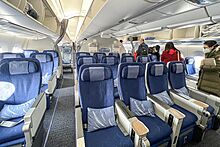
Premium economy is offered on Air China's Airbus A330-300, Airbus A350-900, Boeing 747-8, and Boeing 787-9 planes. These seats offer more legroom and recline more than economy seats. On the A350-900, the seats are arranged in a 2-4-2 pattern. On other planes, they also have good legroom. Some older A330s in this class have entertainment screens.
- Economy Class
Economy class is available on all Air China planes. Many planes have entertainment systems with movies and TV shows. You might also find power outlets and USB ports to charge your devices. Seats usually have enough space for comfort. On Airbus A330s, economy seats are in a 2-4-2 layout. On Airbus A350s and Boeing 787s, they are 3-3-3. Boeing 747s and 777s have a 3-4-3 layout. Most smaller jets have a 3-3 layout.
PhoenixMiles (Frequent Flyer Program)
PhoenixMiles is Air China's frequent flyer program. It is also used by its partner airlines like Air China Inner Mongolia and Air Macau. This was the first program of its kind in mainland China. It rewards people who fly often with Air China and its partners.
Air China Cargo
Air China Cargo is a part of Air China that only carries goods, not passengers. It flies cargo routes across Asia, Europe, and North America. It uses planes like the Airbus A330-200/P2F, Boeing 747-400F, and Boeing 777F.
Incidents
- On April 15, 2002, Air China Flight 129, a Boeing 767-200ER, crashed while trying to land in Busan, South Korea. Sadly, 129 people out of 166 on board passed away.
- On August 27, 2019, Air China Flight 183, an Airbus A330-343X, was damaged by a fire in its cargo area. This happened on the ground at Beijing before it could take off for Tokyo, Japan. No one was hurt in this incident.
See also
 In Spanish: Air China para niños
In Spanish: Air China para niños
- Aviation industry in the People's Republic of China
- List of airlines of the People's Republic of China
- List of airports in the People's Republic of China
- List of companies of the People's Republic of China
- Transportation in the People's Republic of China


